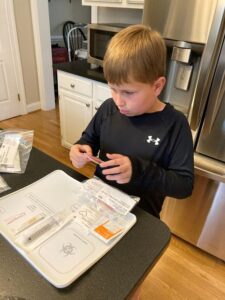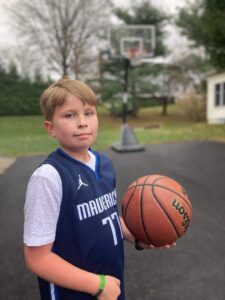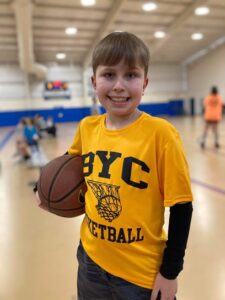Rare Community Profiles

Rare Community Profiles is a new Patient Worthy article series of long-form interviews featuring various stakeholders in the rare disease community, such as patients, their families, advocates, scientists, and more.
Diagnosed Before Birth: How the Sweatman Family Manages Their Son’s Hemophilia A
For as long as she can remember, Allison Sandford-Sweatman has known about hemophilia presentation, symptoms, management. Both of her uncles—her mom’s brothers—had hemophilia. While one uncle died when he was 10 years old due to complications from a bleed, the other lived to be 81 years old (though he faced many challenges in terms of mobility and joint bleeds). This family history became much more pressing when Allison, while pregnant, learned that she was a carrier for hemophilia A (meaning that she “carries” the genetic change for hemophilia). She shares:
“I was surprised because the doctors I spoke with hadn’t come across hemophilia A often. When I requested hemophilia A genetic carrier testing, my doctor’s office seemed unprepared as they didn’t have much experience with a disease so rare. Even when I was at the gynecologist asking about C-sections and natural births, they were pretty low-key about it. I didn’t get a lot of information and found it hard to find resources with relevant experience. They said everything would be fine and, ultimately, it was, but offering more insight is something I think could have really helped me and others in the same situation.”
Given her family history and her carrier status, Allison’s son Griffin was tested for hemophilia A via amniocentesis. The test came back and showed that Griffin did have hemophilia A. Allison explains:
“Having Griffin be diagnosed prior to birth was helpful but worrisome too. On one hand we knew what we were up against given my family history, but it also gave us time to understand what it meant to have hemophilia in current times.”
In her recent interview with Patient Worthy, Allison shares more about hemophilia A, addresses myths and misconceptions, shares Griffin’s story, and offers poignant advice to families.
What is Hemophilia A?
Hemophilia A, also known as factor VIII deficiency or classic hemophilia, is an inherited genetic bleeding disorder. It is inherited as a recessive trait on a parent’s X chromosome. Hemophilia A results from a lack of or defective factor VIII (FVIII), a clotting protein, which prevents the blood from clotting properly. As Allison explains:
“I tell his teachers that he does not initially bleed any differently than other people. It’s just that the length in which it continues to bleed is the issue.”
The severity of hemophilia A varies, though an estimated 60% of those with this condition are believed to have a severe case. Potential symptoms and characteristics of hemophilia A include:
- Bloody urine or stools
- Large, deep bruising
- Frequent or recurrent nose bleeds
- Unexplained irritability (in infants)
- Abnormal or excessive bleeding after cuts, trauma, surgery, or dental work
- Joint pain, swelling, or tightness
- Excessive bleeding or menstruation after childbirth (in women)
Treatment options include concentrated intravenous FVIII, Desmopressin Acetate (DDAVP), and emicizumab (Hemlibra).
Griffin’s Story
Since Allison and her husband John received Griffin’s diagnosis while he was still in the womb, they had the opportunity to prepare before Griffin’s birth. They meticulously planned for his arrival which included researching possible medical providers, care options, and reading all of the information they could find on how to best care for an infant with hemophilia A.
The day they brought Griffin home from the hospital was beautiful and full of love. Their son was safe. He was happy. And he was there. But soon, the reality began to set in. Allison shares:
“When he was little, I was worried for 24 hours a day. Is he going to fall? Is he going to hurt himself? Will the nanny know how to handle this? That constant state of heightened awareness was difficult. In the beginning, I wanted to bubble-wrap him. We used many protections such as Comfy Caps, knee pads inserted into his pants, and bumpers put around the furniture and all the way up the sides of his crib.”
During this time, Allison and John found comfort in the Children’s Hospital of Philadelphia (CHOP). Allison would call as needed for support. Sometimes she knew the answers to her questions but just needed a sounding board. She says:
“I don’t think I’d be as sane as I am today if not for them!”
Fighting Misconceptions and Starting Treatment
As Griffin grew older, Allison found herself fighting misconceptions about hemophilia A. At one potential preschool, an employee told her that they were uncomfortable with Griffin being there as they were concerned he may get a severe bleed from a paper cut. Says Allison:
“I realized that they didn’t know much about hemophilia A. When you say someone’s blood doesn’t clot correctly, people think that a simple cut is going to become an uncontrolled bleed immediately. Blows to the body and internal bleeds are really more worrisome. Something I ask people is to please listen to me rather than the preconceptions.”
When Griffin suffered from a significant bleed in his leg while playing soccer, doctors decided that, from that point, he had to have infusions of factor VIII 2-3 times weekly. The nurse would visit the house to give him infusions. Allison explains:
“He was young, so he didn’t love it. It’s hard to watch your child go through that. It was also somewhat limiting in terms of where we could go or what we could do. Griffin would have to wake up at 6am on treatment days, get his infusion by the nurse, and then head to school. If we wanted to travel, we would schedule our vacations around our infusion calendar.”

Research has come a long way in identifying new and effective therapeutic options for patients with hemophilia. In 2018, the family began treating Griffin’s hemophilia A with Hemlibra. Allison shares:
“We do his treatment at home once every two weeks, and it goes so quickly now. Griffin gets his medicine boxes from upstairs and brings all the needles, syringes, and alcohol swabs to the table. I prepare the syringe and my husband does the shot. It takes a few minutes and then we move on with our lives.”
Managing Hemophilia A Over Time
Allison still goes to Griffin’s school each year to train the teachers on hemophilia A and shares Griffin’s story. Says Allison:
“My parents never really wanted to talk about hemophilia, but I took a very different approach. I believe that communication and openness are very important. Taking this position has also helped Griffin talk about everything more freely and therefore makes others around him feel more comfortable. One of the biggest fears I had when he was born was how and when to tell him that he had hemophilia. I often worried about how he would handle it. I decided instead of telling him about everything all at once, I gave him the information on an as needed basis as events occurred. This gave him the chance to absorb everything slowly. And now, he just accepts hemophilia as part of his life and who he is.”

This focus on increased awareness and understanding has also helped the family outside of the school setting. Griffin plays basketball and is a huge fan of the sport; he’s in three different basketball leagues currently! Allison laughs as she says:
“When he scores, he basically skips. For someone who thought he might not be able to play, being on the court is a dream come true. He exudes happiness. As he has become more active in sports, we’ve found that awareness is the most crucial part of protection. Sure, he still has physical safeguards such as his Medic Alert bracelet thumb wraps worn during games and his emergency medicine and ice packs on the sidelines but knowing that his teammates and coaches understand is so important.”
One of Griffin’s basketball teams even recently won their league championship following a strong season and a hard-fought weekend. Go Griffin!
Griffin Today

This year, Griffin turns 11 in April—and he is already living his life to the fullest! When Griffin isn’t playing basketball, he is the ultimate gamer; he has an Oculus VR headset and loves to play virtual football. Allison describes him as very social: playing with friends, hanging out at birthday parties, attending summer camp, and chatting with everyone at school about his favorite professional athletes.
Allison’s family is from the United Kingdom, so Allison, John, and Griffin have planned a trip to visit this spring! This is the first time that Griffin is able to travel outside of the country. On one hand, this is a little frightening – but John and Allison are prepared. They have their cooler ready to transport Griffin’s treatment safely. Overall, the family is so excited for this new journey.
Most of all, Allison is impressed by her son’s strength, determination, and self-confidence. In a recent conversation, Allison asked if Griffin would want gene therapy—a single dose and a different story—if it was developed for hemophilia A. She shares:
“He thought about it and then said, ‘I’m not sure. I’m excited about gene therapy, but hemophilia is part of me. I can’t imagine life without it.’ It was amazing. I thought he’d say that he wanted his hemophilia to be gone. So far, he has lived every day to its fullest and never looked back. Has this been an easy journey? No. But is it rewarding? When I see my son, absolutely.”
Offering Advice
When the Sweatman family’s journey first began, Allison stayed out of the Facebook groups and other social media platforms that were talking about hemophilia. She wanted to know how to handle and understand hemophilia A—and what it meant for Griffin and their family—before joining. Her “small but mighty” circle of family, friends and medical team offered just the right amount of support needed at the time. Eventually, she joined the groups, ready to learn, talk, and contribute. For others, she says:
“Each family and patient will have a different story to tell about what it is like to have hemophilia. I believe it’s important to understand your own story first as the impact of hemophilia on one’s life can differ substantially. Feeling confident in your own shoes helps you to absorb new information without being influenced unnecessarily.”
Outside of that, Allison wants new parents in the hemophilia community to know that they are not alone and that there is help out there. And that, most of all, this journey does not have to be as frightening as it may seem at the beginning. As a reminder, Allison shares (as others shared with her when Griffin was born):
“There are so many advancements in treatment now. A new diagnosis may be hard to digest initially, but your child can have a good life. Don’t be afraid, just take it one day at a time.”






